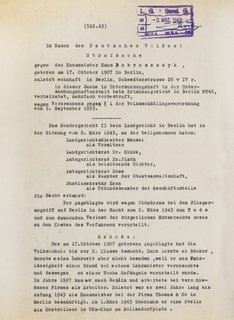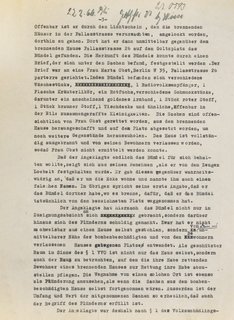From 1938 all crimes, and from 1939 all misdemeanors, could be brought before the Special Courts, which were presided over by three professional judges and which passed verdicts as courts of first and last instance. Wartime criminal law allowed for death sentences for almost any criminal offense. The Special Courts interpreted this martial law broadly, passing a large number of death sentences even for petty crimes and first offenses.
According to § 1 of the “decree regarding parasites on the nation,” “looters” who committed theft during or after air raids were to be sentenced to death. In 1942, “looters chambers” were established at every Special Court, convening after major air raids and passing death sentences in summary trials. lmmediately after the bombings, these executions were announced, as a deterrent, on red posters.
Roland Freisler was the presiding judge at the “People’s Court” from 1942 on. He humiliated and mocked the defendants. Laws were systematically interpreted in an arbitrary manner, and death sentences were “justified” in very brief form only. The “People’s Court” committed judicial killings.
The janitor Hans Dobroszczyk, born in 1907, took on an extra job on March 1, 1943, as a ticket inspector in the Ufa cinema on Nollendorfplatz. He was denounced in the early morning of March 2, 1943, for picking up a bag on a ruined lot after an air raid. This act was categorized as “looting.” He was arrested, accused, and sentenced to death that same day by Special Court II at the Berlin Regional Court. On the morning of the next day, March 3, 1943, Hans Dobroszczyk was beheaded in Plötzensee prison.


